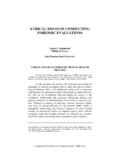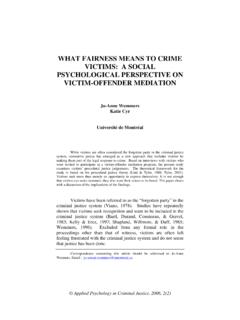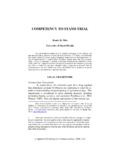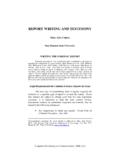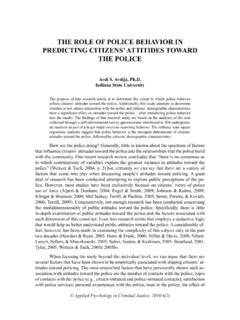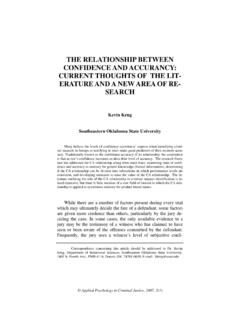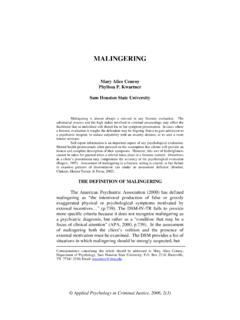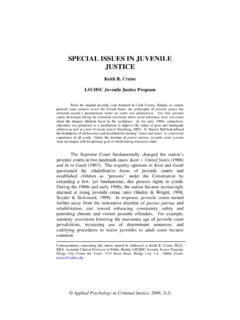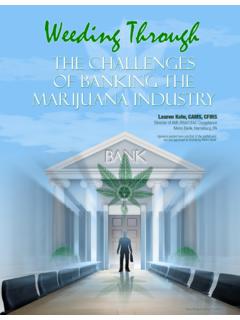Transcription of An eMPiriCAl AnAlysis oF The relATionshiP BeTween …
1 Applied Psychology in Criminal Justice, 2009, 5(2)An eMPiriCAl AnAlysis oF The relATionshiP BeTween lAW, morality , and personal conduct : implications For Theory And PoliCy*henry F. FradellaCalifornia State university, long BeachBrenda vogelCalifornia State university, long BeachScholars have long engaged in an intellectual struggle to define the relATionshiP BeTween law and morality , a task that is especially complex when examining criminalization. To date, however, the so-called Hart Devlin debate on the social control of morals through criminal law has been largely theoretical.
2 This study empirically examines the link BeTween perceptions of morality and correspond-ing views on criminalization on 11 low-consensus deviant behaviors, including drug offenses, victimless sex offenses, and criminal traffic offenses. Moreover, it examines the relATionshiP BeTween perceptions of law and morality on personal conduct that violates both social norms and criminal law. The analyses find strong support for an eMPiriCAl link BeTween conceptualizations of that which is per-ceived as immoral and that which is perceived as warranting criminal sanction for drug and traffic offense, but not for consensual sexual conduct .
3 The analyses also support the proposition that morality appears to be a stronger mediator of deviant behavior than the law. Scholars have long engaged in an intellectual struggle to define the relATionshiP BeTween law and morality (Aristotle, c. 350 ; Devlin, 1965; Hart, 1963; Hume, 1739/1978; Kant, 1785/1996; Plato, c. 360 ; Rawls, 1972; Rousseau, 1762/1979). morality has also been an integral part of the study of Correspondence concerning this article should be addressed to Henry F. Fradella, California State University, Long Beach, 1250 Bellflower Boulevard, Long Beach, CA 90840; Phone: (562) 985-2669; Email: Brenda Vogel, California State University, Long Beach, 1250 Bellflower Boulevard, Long Beach, CA 90840; Phone: (562) 985-1894; Email: AN eMPiriCAl EXAMINATION OF LAW AND morality Applied Psychology in Criminal Justice, 2009, 5(2)psychology since its early roots (Freud, 1930/2005; Gilligan, 1982; Kohlberg, 1964, 1981, 1984; Piaget, 1932/1965).
4 In spite of the per-vasiveness of morality as a topic of research in the humanities and social sciences, criminal justice has largely neglected morality as a variable even though it plays a role in both Social Control Theory and Social Learning Theory (Akers, 1985; Hirschi, 1969). eMPiriCAl tests of these theories have demonstrated that moral belief systems are related to one s propensity to engage in criminal behaviors ( , Akers & Cochran, 1985; Antonaccio & Tittle, 2008; Bachman, Paternoster, & Ward, 1992; Evans, Cullen, Burton, Dunaway, & Benson, 1997; Krohn & Massey, 1980; Matsueda, 1989; Wikstr m & Treiber, 2007).
5 Yet, in spite of such evidence, the effect of (lack of) morality in explaining criminal behavior has not been widely ex-plored, nor has its import relative to other variables been fully deter-mined (Antonaccio & Tittle, 2008, p. 481). Moreover, in addition to its role in criminological theory, the connection BeTween law, mo-rality, and specific aspects of the criminal justice system have only recently begun to be explored (Carrier, 2007; Lambert, Pasupuleti, & Jiang, 2008; Lee & Rasinski, 2006; Rogers, Smoak, & Liu, 2006; Simpson, 2005). The present study helps to fill this void in the lit-erature by investigating the link BeTween law and morality as they affect several concrete criminal behaviors that have previously been identified as low-consensus deviance (see Winslow & Gay, 1993).
6 Review oF The liTerATUreAn Overview of the Links BeTween Law and MoralitySince the mid-1960s, the ongoing debate regarding the link BeTween criminal law and morality has often been referred to as the Hart-Devlin Debate (Lee, 1986; Strong, 1997), stemming from the writings of Professor Hart and Lord Patrick Devlin. Although arguments about the link BeTween law and morality have ancient roots (cf. Aristotle, c. 350 ; Plato, c. 360 ), the specific debate BeTween Hart and Devlin took shape following the issuance of the Wolfenden Report (1957), a study commissioned by Great Britain s Parliament to examine whether to decriminalize England s sodomy laws (Strong, 1997; Summers, 2005).
7 While Hart and Devlin disputed the decriminalization recommendations in the FRADELLA AND VOGEL 205 Applied Psychology in Criminal Justice, 2009, 5(2)Wolfenden Report, their disagreement ran much deeper than hold-ing differing opinions on the legalization of sodomy. They funda-mentally disagreed about the legitimacy of the criminal law being used to enforce morality in the absence of palpable Devlin s position at first appears to be a legal moralist one, that point is open to debate (see Murphy, 1995). Regardless of the label applied to it, though, it is clear that Devlin asserted that no society could exist without a shared, public morality (Devlin, 1962).
8 This conceptualization that society is held together by shared moral beliefs extends beyond jurisprudential scholars; Emile Durkheim (1893/1964) posited this view, as did Plato in The Republic. But beyond his views on shared morality , Devlin argued that the crimi-nal law should be used as a mechanism for the enforcement of this public morality . Devlin s beliefs on the propriety of using law in this manner were deeply rooted in the philosophy of Plato who believed the State exists to promote virtue among its citizens (Devlin, 1965, p. 89).
9 For Devlin, the state was not only philosophically justified in exercising the criminal sanction to protect society from moral decay, but it had a moral responsibility to do so. In contrast, Hart (1963, 1967) argued the classical liberal view on the criminal law. Liberalism s concern for a non-coercive state has its early roots in Aristotelian philosophy, as Aristotle (c. 350 ) did not believe that being moral was a legitimate state concern (see Strong, 1997). But modern liberal thought has been shaped significantly by the writings of the utilitarian philosophers (see Bentham, 1843/1988; Mill, 1859/1956).
10 This position rejects the notion that the criminal law should be used as a mechanism for the enforcement of public morality . Rather, it asserts that the only mor-ally permissible exercise of the criminal sanction is to prevent harm to others (Bentham, 1843/1988; see also Gruen & Panichas, 1997).Neither Hart nor Devlin s position provides sufficient guid-ance to formulate good public policy. Meier and Geis (1997), for example, point out that while there can be no doubt that the criminal law is designed to protect against harm especially harms that en-206 AN eMPiriCAl EXAMINATION OF LAW AND morality Applied Psychology in Criminal Justice, 2009, 5(2)danger physical injury and life, or those that involve loss of liberty or property it is neither consistent nor comprehensive in afford-ing such protection (p.)
